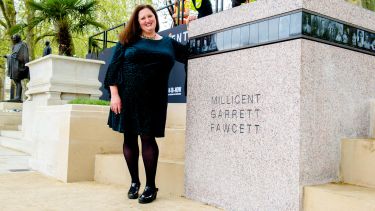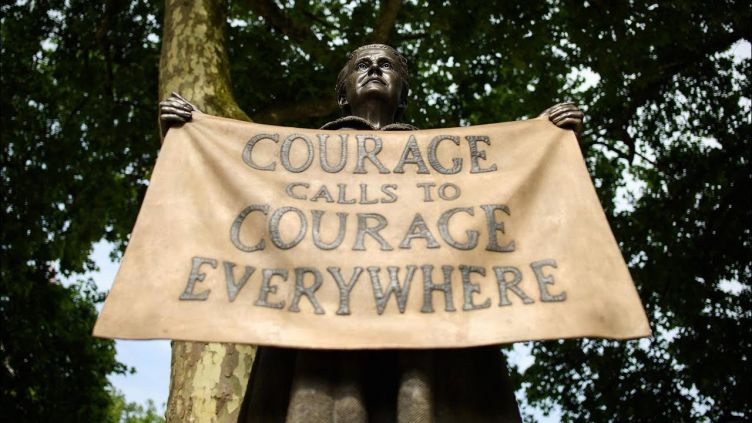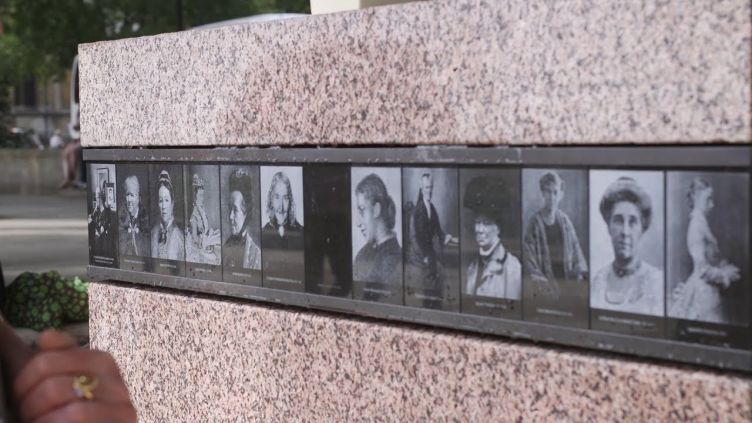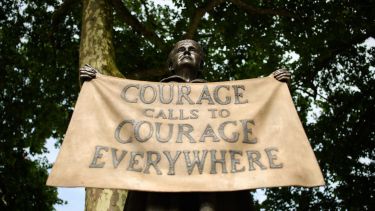Millicent Fawcett: A statue to suffrage
When the statue of suffragist Millicent Fawcett was unveiled in 2018 it broke Parliament Square’s granite ceiling to become the first representation of a woman in the city’s seat of power. Professor Julie Gottlieb’s advice and collaboration helped carve this place in history.

Introduction
Professor Julie Gottlieb doesn’t describe herself as the type to be star struck, but her fellow guests assembled on a warm spring morning in Parliament Square - including Sadiq Khan, Theresa May and Jeremy Corbyn - must have reinforced the sense of occasion. London’s Parliament Square faces Westminster, the nation’s seat of power but it’s also a celebrated place of protest and dissent. Today, everyone was united.
The official unveiling of the statue of Millicent Fawcett, brought together politicians of every hue to witness a woman take her place as an equal alongside 11 statesmen including Winston Churchill and Lloyd George.
Fawcett was a shrewd and tireless campaigner and leader, who resolutely broke down the barriers to women’s suffrage. But this fight for the right to vote was not the work of one woman. Gottlieb worked with Wearing and historians from across the UK on a statue that would reflect the conception and ambition of the women’s suffrage movement. When the black cloth was pulled away to reveal her sculpture, Fawcett was not alone.
The plinth of the sculpture was lined with photographic images of 59 other suffrage campaigners who’d been etched into granite.
Women’s history is about movements, it’s about networks, it’s about relationships, political and personal. The plinth’s figures are there to show that no one person can make political change happen
Professor Julie Gottlieb
Professor in Modern History at the University of Sheffield
So how do you represent a collective struggle in a statue? How do you assess the lives and achievements of hundreds of campaigners to chose 59 individuals? Where do you start?
In the beginning
The story of Fawcett’s statue starts with a twenty-first century woman’s tireless campaign for women’s representation.
Journalist and activist Caroline Criado-Perez, who campaigned to get a woman on the ten-pound note, was jogging through Parliament Square when she noticed that every figure on a plinth was male. Determined to get a woman in the square, she led a huge campaign, attracting the support of tens of thousands of supporters through an online petition.
Her campaign won the support of the Mayor of London, Sadiq Khan, and the statue was co-curated by the Mayor of London’s Office and First World War Arts Project 14-18 Now, as a central part of the Vote 100 commemorations. CAS Consultancy were appointed by the Mayor of London to manage the artwork commission, and Turner-prize winning artist Gillian Wearing was chosen as sculptor.
Gottlieb was approached to be historical consultant to Wearing less than a year before the statue was due to be unveiled. Her research on British women’s citizenship and activism across the political spectrum gave her a distinctive view on the challenge of identifying the women to line the plinth. “I had the chance to use academic knowledge for transformative impact, to make a real difference,” as she describes it.
Meeting for the first time in a café on London’s Euston Road, Wearing was particularly struck by Gottlieb’s view of history. “I remember one very interesting bit of information, which I hadn’t really thought about before. History often remembers people and events at a future time when it becomes relevant. We’re all part of re-interpreting historical events…” That discussion on the ways in which people are written in and out of history, “…Helped me really think about how you shape history.”
Julie would help Gillian draw up a list of individuals for inclusion around the plinth, aiming to achieve the greatest diversity along national, regional, gender, sexual, class, political, generational, religious and ethnic lines.
It was a discussion that highlighted the importance of the role Gottlieb and Wearing would play in contributing to women’s history. Whoever was on the statue would be remembered in a very public way, in a public space, and likely for centuries to come.
So where to start? Historians ‘go where the documents are’, as Gottlieb describes it when we meet to discuss the impact of her work as historical consultant on the project. But for over 50 years following women’s suffrage, the broader history of the movement and many individuals were ignored, overlooked by male scholars at the time.
The easiest stories to find were from the suffragettes who seemingly predicted this course of events and preserved their stories for the archive through the Suffragette Fellowship.
However, their stories were not fully scrutinized until the second-wave feminists rescued them from obscurity, as they sought to celebrate Votes for Women 50 years on in 1968.
These were the ‘breadcrumbs’ for women’s historians who would help to start re-writing women back into history. They would also help inform the list of campaigners to line the plinth of Fawcett’s statue. But the suffrage campaign involved many more groups than just the eponymous suffragette in purple, green and white chaining herself to railings.
Making the list
Gottlieb believed it was vital for the statue to represent the diversity of the suffrage movement, so that it wouldn’t just be about one person or faction engaged in the struggle.
That meant representing both the suffragist and suffragette branches of the campaign, as well as digging deep into the dozens of other organisations campaigning for the vote, representing different religions, geographical regions and occupations…
…And politics. Gottlieb was keenly aware that Conservative women could have been excluded from the list, given the prevailing assumption about their anti-progressive stance on gender issues. Her lead in a previous research project – ‘Conserving Conservative Women’ – had acquainted her with a significant vein of Conservative suffrage campaigners, which led to including women’s rights activist Lady Maud Selbourne on the list.
Gottlieb called upon the expertise of historians across the country to identify the 59. “I saw myself as a hub.” As she describes it. “I drew on the work and conversations with experts on various aspects of the movement, and it was about consulting people. Forging new relationships and building networks of partners to collaborate with has been one of the things I’ve really enjoyed in my career. This collaborative approach was, I think, in the spirit of the whole project.”
But the march of women’s progress didn’t end in 1918 when the vote was won. In Julie’s mind, the vote was the start not the end. She wanted to use the statue to tell the stories of women whose suffrage afterlives, their careers and contributions after the vote was won, were as vibrant and transformative as their pre-war feminist activism.
Working with Wearing, Julie extended the scope to include suffragist Ellen Wilkinson, who became a Labour MP and the second female Cabinet Minister, and Helena Swanwick, pacifist, peace campaigner and key figure in international relations between the wars.
A permanent place
A couple of months on from that first meeting with Gillian Wearing, Gottlieb sat in an office in London City Hall with the whole project team, Wearing and Criado-Perez in attendance, to finalise the list. Eight months later, April 24th 2018, she was waiting in the crowd for the statue to be unveiled.
Alongside famous names like the martyr Emily Wilding Davison and the militant Pankhursts, the list included suffrage campaigners from Wales, Ireland, Scotland and the North of England, representatives of ethnic minorities such as Indian princess Sophia Duleep Singh, and Henrietta Franklin, education reformer and leader of the Jewish League for Woman Suffrage. Sharing a tile is the lesbian couple Esther Roper and Eva Gore-Booth, and Rosa May Billinghurst is featured, a disabled survivor of polio who founded a branch of suffragettes in Greenwich.
The decisions Gottlieb helped to make about whose portraits were etched in the plinth of Fawcett’s statue will have a profound and lasting impact on the framing of the story of women’s political emancipation.
It’s a reminder that the right to vote wasn’t the achievement of one man or woman – it was a collective struggle. With the fight for gender equality high on the agenda today, history can provide the inspiration to shape the future. “Anniversaries aren’t just opportunities to look back and reflect.” Gottlieb reflects. “They’re moments when we mobilise, when we think about how the past can powerfully inform the future. The statue of Millicent Fawcett, accompanied by fascinating and diverse campaigners for suffrage, is a permanent marker of the pioneering courage needed to demand change.”






